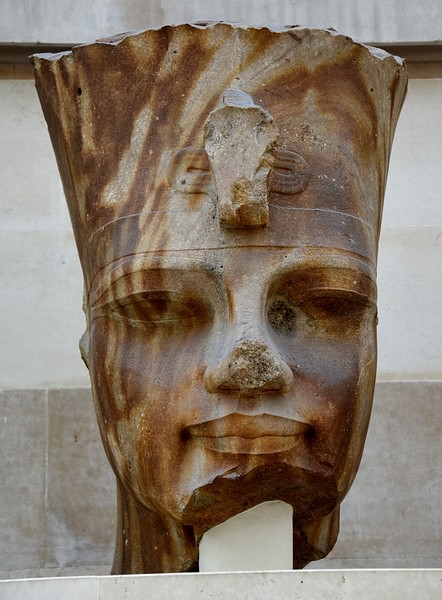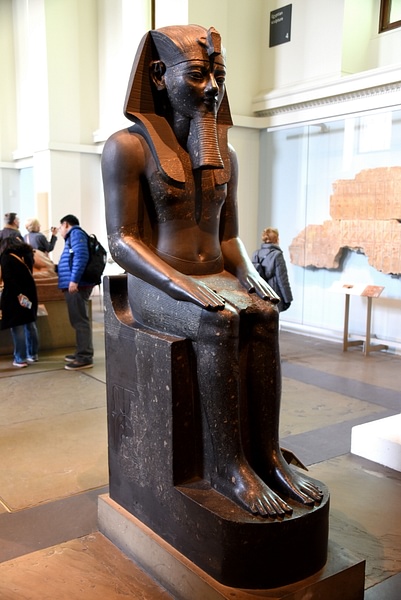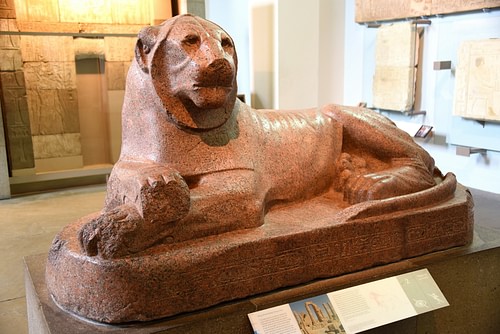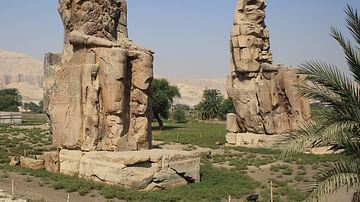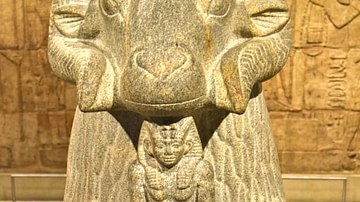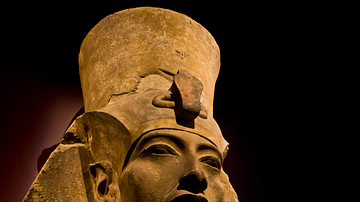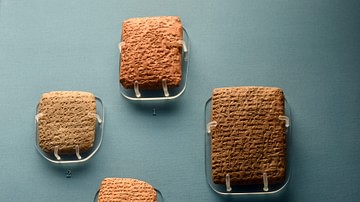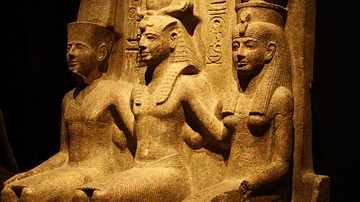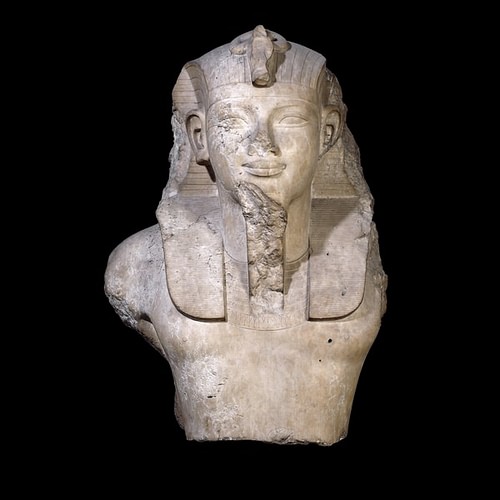
Amenhotep III (c. 1386-1353 BCE) was the ninth king of the 18th Dynasty of Egypt. He is also known as Nebma'atre, Amenophis III, Amunhotep II, and Amana-Hatpa, all of which relate to the concept of the god Amun being satisfied or, as in the case of Nebma'atre, with the ideal of satisfied balance, ma'at.
He was the son of the pharaoh Tuthmosis IV and his lesser wife Mutemwiya, husband of Queen Tiye, father of Akhenaten, and grandfather of Tutankhamun and Ankhsenamun. His greatest contribution to Egyptian culture was in maintaining peace and prosperity, which enabled him to devote his time to the arts.
Many of the most impressive structures of ancient Egypt were built under his reign and, through military campaigns, he not only strengthened the borders of his land but expanded them. He ruled Egypt with Tiye for 38 years until his death and was succeeded by Amenhotep IV, later known as Akhenaten.
Amenhotep III's Opulent Reign
Amenhotep's father, Tuthmosis IV, left his son an empire of immense size, wealth, and power. The Egyptologist Zahi Hawass writes, “Amenhotep III was born into a world where Egypt reigned supreme. Its coffers were filled with gold, and its vassals bowed down before the mighty rulers of the Two Lands [Egypt]” (27). He was only twelve years old when he came to the throne and married Tiye in a royal ceremony. It is a significant aspect of Amenhotep's relationship with his wife that, immediately after their marriage, she was elevated to the rank of Great Royal Wife, an honor which Amenhotep's mother, Mutemwiya, was never accorded and which effectively meant that Tiye outranked the king's mother in courtly matters.
His marriage completed, the king set about continuing the policies of his father and implementing new building programs throughout Egypt. He was a master of diplomacy, who placed other nations in his debt through lavish gifts of gold so that they would be inclined to bend to his wishes, which they invariably did. His generosity to friendly kings was well established, and he enjoyed profitable relationships with the surrounding nations.
He was also known as a great hunter and sportsman and boasted in an inscription that “the total number of lions killed by His Majesty with his own arrows, from the first to the tenth year [of his reign] was 102 wild lions” (Nardo, 19). Further, Amenhotep III was an adept military leader who “probably fought, or directed his military commanders, in one campaign in Nubia and he had inscriptions made to commemorate that expedition” (Bunson, 18).
He maintained the honor of Egyptian women in refusing requests to send them as wives to foreign rulers, claiming that no daughter of Egypt had ever been sent to a foreign land and would not be sent under his reign. In all these ways, Amenhotep III emulated or improved upon his father's policies, and in religion he did likewise. Amenhotep III was an ardent supporter of the ancient Egyptian religion and, in this, found a perfect outlet for his greatest interest: the arts and building projects.
Monumental Constructions
The historian Durant describes the grandeur of Amenhotep's monuments in writing, “Two giants [sit] in stone, representing the most luxurious of Egypt's monarchs, Amenhotep III. Each is seventy feet high, weighs seven hundred tons, and is carved out of a single rock” (141). Amenhotep III's vision was of an Egypt so splendid that it would leave one in awe, and the over 250 buildings, temples, statuary, and stele he ordered constructed attest to his success in this.
The statues which Durant mentions are today known as the Colossi of Memnon and are the only pieces left of Amenhotep III's mortuary temple. Their immense size and intricacy of detail, however, suggest that the temple itself – and his other building projects no longer extant – were equally or even more impressive.
Among these projects was the new pleasure palace at Malkata, on the west bank of the Nile, just across from the capital of Thebes. Bunson writes:
The vast complex was called `The House of Nebma'atre as Aten's Splendour.' The resort boasted a lake over a mile long, which appears to have been created in only 15 days by advanced hydraulic sluicing techniques. The complex contained residences for the Queen Tiye and for Akhenaten, the king's son and heir. Amenhotep even had a pleasure bark, dedicated to the god Aten, built for outings on the lake. (18)
He frequently took these outings in the company of Tiye and, it seems, she was often his closest companion in both public and private life. Tiye, in fact, operated on a nearly equal, or completely equal, status to her husband and is often depicted in statuary as the same height as he is, symbolizing the harmony and equality of their relationship. While Amenhotep was busy with his building projects, Tiye took care of the affairs of state and running the palace complex at Malkata.
That she was kept quite busy with these tasks is evident in letters from foreign rulers as well as the number of buildings constructed during Amenhotep III's reign. In addition to those already mentioned, he had 600 statues of the goddess Sekhmet erected around the Temple of Mut, south of Karnak, renovated the existing Temple at Karnak, built temples to Amun, erected statuary depicting Amun, raised stele which recorded his accomplishments, set the granite lions in front of the Temple of Soleb in Nubia, and decorated walls and monuments with scenes depicting his exploits and the pleasure the gods had in him.
In his first year of rule, he had new limestone quarries dug in the region of Tura, and throughout his reign, he depleted them. Images of the pharaoh and his gods spread across the plains and valleys of Egypt and cities were refurbished. Roads were improved and travel became easier. The ease of travel helped merchants get their wares to market more quickly and this, of course, boosted the economy. With revenue already coming in from vassal states, Egypt became increasingly wealthy under Amenhotep III's reign. The populace was content and the power of the throne was stable except for the threat from the priests of the cult of the god Amun.
The Sun God & the Priests of Amun
There was another power in Egypt which had been growing long before Amenhotep III came to the throne: the cult of Amun. Land ownership meant wealth in Egypt and, by Amenhotep III's time, the priests of Amun owned almost as much land as the king. In accordance with traditional religious practice, Amenhotep III did nothing to interfere with the work of the priests, but it is thought that their immense wealth, and threat to the power of the throne, had a profound effect on his son.
The god Aten was only one of many gods worshipped in ancient Egypt but, for the royal family, he had a special significance which would later become manifest in the religious edicts of Akhenaten. At this time, however, the god was simply another worshipped alongside the rest.
Perhaps in an attempt to wrest some power from the priests of Amun, Amenhotep III identified himself with Aten more directly than any pharaoh had previously. Aten was a minor sun god, but Amenhotep III elevated him to the level of a personal deity of pharaoh. Hawass writes:
The sun god was a complex creature, whose dogma had been developing for thousands of years. In addition to his main incarnation as Re, this god was associated with the creator Atum as well as with deities such as Khepri…and Osiris, with whom Re merged at night. Another aspect of this god was the Aten; according to texts dating back at least to the Middle Kingdom, this was the disk of the sun, with which the king merged at death. This divine aspect, unusual in that it was not anthropomorphic, was chosen by Amenhotep III as a primary focus of his incarnation. It has been suggested that the rise of the Aten was linked specifically with maintenance of the empire, as the area over which, at least theoretically, the sun ruled. By associating himself with the visible disk of the sun, the king put himself symbolically over all the lands where it could be seen – all the known world, in fact. (31)
Amenhotep III's elevation of Aten as his personal god was not uncommon. Pharaohs in the past were associated with a particular cult of a favored god and, obviously, Amenhotep III did not neglect the other gods in preference to Aten. If his goal in raising awareness of Aten was politically motivated, it did not accomplish very much at all during his reign. The cult of Amun continued to grow and amass wealth and, in doing so, continued to pose a threat to the royal family and the authority of the throne.
Amenhotep's Death & the Reign of Akhenaten
Amenhotep III suffered from severe dental problems, arthritis, and possibly obesity in his final years. He wrote to Tushratta, the king of Mitanni (one of whose daughters, Tadukhepa, was among Amenhotep III's lesser wives) to send him the statue of Ishtar that had visited Egypt before, at his wedding to Tadukhepa, to heal him. Whether the statue was sent is a matter of controversy in the modern day and what, precisely, was ailing Amenhotep III is likewise. It has been suggested that his dental problems resulted in an abscess which killed him, but this has been disputed.
He died in 1353 BCE, and letters from foreign rulers, such as Tushratta, express their grief on his passing and their condolences to Queen Tiye. These letters also make clear that these monarchs hoped to continue the same good relations with Egypt under the new king as they had with Amenhotep III. With Amenhotep III's passing, his son, then called Amenhotep IV, began his reign.
At first, there was nothing which distinguished Amenhotep IV's rule from that of his father; temples were raised and monuments built just as before. In the fifth year of his reign, however, the new pharaoh underwent a religious conversion and outlawed the ancient religion of Egypt, closed the temples, and proscribed all religious practice. In place of the old faith, the king instituted a new one: Atenism. He changed his name to Akhenaten and created the first state-mandated monotheistic system in the world.
Akhenaten continued to build monuments and temples just as his father had, but “these temples were not to Amun, but to the sun disk as the Aten” (Hawass, 36). The Aten was now the one true god of the universe, and Akhenaten was the living embodiment of this god. The new king abandoned the palace at Thebes and built a new city, Akhetaten (`the horizon of Aten', also known as Amarna) on virgin land in the middle of Egypt.
From his new palace, he issued his royal decrees but seems to have spent most of his time on his religious reforms and neglected the affairs of state and, especially, foreign affairs. Vassal states, such as Byblos, were lost to Egypt, and the hopes which foreign rulers had expressed in continuing good relations with Egypt were disappointed.
Akhenaten's wife, Queen Nefertiti, assumed the responsibilities of her husband and, though she was adept at this, his neglect of his duties had already resulted in enormous loss of Egypt's wealth and prestige. During the Amarna Period, the treasury was slowly depleted, military discipline and efficacy was lax, and the people of Egypt, deprived of their traditional religious beliefs and the financial benefits associated with religious practices, suffered.
Those who had once sold statuary or amulets or charms outside of temples no longer had a job, as the selling of such objects was illegal, and those who worked in, or for, those temples were also unemployed. Foreign affairs were neglected as completely as the domestic and, by the time of Akhenaten's death in 1336 BCE, Egypt had fallen far from its height under the reign of Amenhotep III.
Akhenaten's son and successor, Tutankhamun, tried to reverse the fortunes of his country in the brief ten years of his reign but died at the age of 18 before he could accomplish his goals. He did, however, overturn his father's religious reforms, open the temples, and re-establish the old religion. His successor, Ay, continued these policies, but it would be Ay's successor, Horemheb, who would completely erase, or try to, the damage done to the country by Akhenaten's policies.
Horemheb destroyed the city of Akhetaten, tore down the temples and monuments to Aten, and did this so thoroughly that later generations of Egyptians believed that he was the successor to Amenhotep III. Horemheb restored Egypt to the prosperity it had enjoyed before Akhenaten's reign, but Egypt never was able to manage the heights it had enjoyed under Amenhotep III, the luxurious pharaoh, diplomat, hunter, warrior, and great architect of Egyptian monuments.
